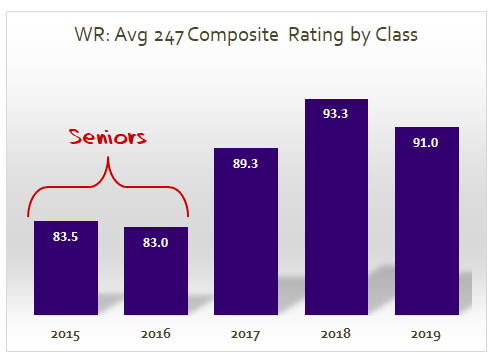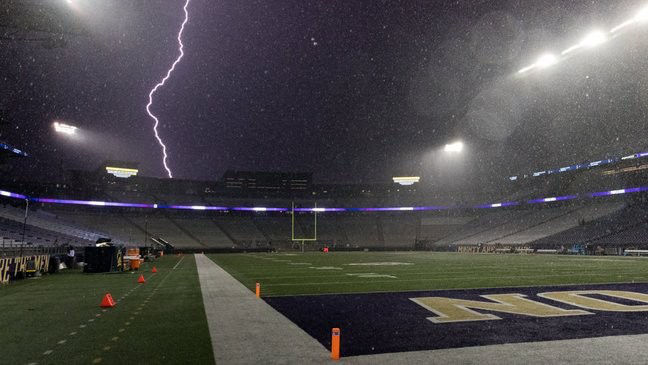We Have to Talk About It: Cal Aftermath
Sunday morning was rough. I spent most of it just trying to process exactly what had happened just a few hours earlier at Husky Stadium, before moving on to watching John Ross III ball out against the Seahawks, napping a bit, and cleaning the garage in the afternoon. While those were all helpful distractions, there is no avoiding the fact that there are some things we need to come to terms with.
It was just one game and it was a weird one, for sure, but there were several aspects of it that weren’t unique or particularly surprising, when you step back and examine it with a critical eye.
Let me also make it clear that I am not somebody who goes nuts after every loss. That just isn’t my MO. I tend towards being extremely analytical and logical in examining these things, particularly after losses. It’s probably a defense mechanism that I use because I care too much, but we aren’t here to delve into my psychology and coping strategies.
The Small Picture: Weird Sh*t Happens in Football
An unprecedented weather delay, blown containment on defense (mostly in the third quarter), dropped passes and tragic red zone scoring efficiency on offense decided this game. The first three items on that list were things we aren’t used to seeing. And if you take away any one or two of the four, the game probably is a close victory, rather than a heart-breaking defeat.


It would be easy and comforting to just chalk the whole thing up to being the product of a random combination of a bunch of improbable circumstances. And despite the disappointing outcome, there were several positives to take away from the game, namely:
- The Husky defense held Cal to 86 yards of total offense in the first half and five of Cal’s ten total possessions gained less than 10 yards total. The Husky defense was stifling during the first half and Cal’s offense looked thoroughly outmatched on those possessions.
- For the second game in a row, the Washington Special Teams played pretty well overall, which is a monumental turnaround from last season’s horrific performance in all phases of ST play. Shout out to Peyton Henry for nailing a 49 yard field goal, a career long for him, and for going 4-for-4 on field goal attempts overall.
- After looking indecisive and proving pretty ineffective in the EWU game, junior RB Salvon Ahmed played like a boss, He showed off his trademark speed on his 21 yard burst to score the Huskies’ only touchdown and he ran hard throughout the game, ending up with 119 yards and a 5.7 yards per carry average.
- While Jacob Eason’s final stat line ended up being pretty ugly, it would have been FAR better without all of those dropped passes. His two turnovers were costly, but the interception he threw was about eight inches from being an absolutely perfect throw. Against a defensive backfield as good as Cal’s that thin margin can be the difference between a huge gain and a turnover.
While all these things are true as far as they go, my view is that this wasn’t just a random coincidence and that viewing this game in isolation is myopic and leads to missing some bigger picture themes.
Meta View: A Perfect Storm of Things We have Been Worried About
We just can’t pretend we didn’t see something like this coming. The fact it came against Cal, at home, rates as a minor surprise. But it was the inevitable byproduct of several systematic issues that we have been talking and worrying about for a while.
Paying for Past Recruiting Sins
The most obvious big-picture theme is that recruiting sins of the past have come back to haunt us.
Defensive Front
During the 2016 and 2017 classes the recruiting numbers at DL and LB were clearly inadequate. This isn’t a 20/20 hindsight thing; it was glaringly obvious at the time.
In the 2016 recruiting class the Huskies signed a grand total of four players who could have been projected to play in the UW defensive front, including two true LBs (Brandon Wellington and Camillo Eifler), one BUCK prospect (Amandre Williams), and one DL (Levi Onwuzuirke). Two of those guys are starting and the other two (Eifler and Williams) departed the program via transfer.
The numbers in 2017 were even more paltry. A class that included just three defensive front players turned into only two when DL Ali Gaye failed to qualify and had to head off to Garden City (KS) Community College to try and get eligible. That left OLBs Ariel Ngata and Joe Tryon as the only defensive front players in the class. Yes, that is an entire recruiting class without a single recruit that could be reasonably projected to play as a true DL or ILB in our defense.
So, to summarize, through two classes they signed a grand total of seven guys for the defensive front, only six of whom matriculated at UW. And two of the remaining six transferred elsewhere. That this could result in a problem down the line was imminently foreseeable. In fact, Dennis and Coker were sounding the alarms about it three years ago on the TSIO podcast.
The net result is that there are just a small handful of third and fourth year players at those position groups on the roster right now. Adding in Temple transfer Josiah Bronson at DL and fifth year hold-over ILB Kyler Manu has only improved matters marginally, from a numbers perspective.
Recruiting mistakes are generally felt 3-4 years later. Having a single hole in a class can sometimes be rectified by making up for it the next year or by moving players from an “adjacent” position group. But whiffing two years in a row is tough to hide. Especially when it happens at multiple positions across the defensive front.


The only thing that has saved us from abject disaster has been Ikaika Malloe’s unbelievable recruiting on the DL in the 2018 and 2019 classes. The fact he landed multiple super-studs who were capable of not only playing early but playing well right out of the gate has been a life saver. Unfortunately, there has been some attrition there already in the form of Mosiah Nasili-Kite’s dismissal from the team on the eve of Fall camp.
The situation at LB might just be worse. The numbers were just as inadequate, if not more so, and the younger players that were signed in 2018 and 2019 look less ready to step up, with the exception of 2019 superstar BUCK Laiatu Latu. And the injury bug has hit the ILB group, with 2019 stud Josh Calvert out for the season and his compadre Danny “Hammer” Heimuli mostly appearing in street clothes, due to an injury of unknown severity.
When there are problems with run fits, tackling, and containment on defense, a lot of that comes down to having to play young players who aren’t really ready for prime time. That is 100% attributable to past recruiting mistakes and was completely forseeable.
Wide Receiver
I really want to be careful and sensitive in how I talk about this. Once they are Huskies, I support all of our players. I want them all to be successful, whether they are highly recruited super-stars in the making, or little known “sleeper” recruits. But to really analyze what is going on, one has to be willing to make real critiques and tell the truth.


And the fact is that our upper class wide receivers are simply not as talented as we need to be the kind of team we all want to have. And the older receivers are, without exception, undersized. The recruiting classes of 2017 – 2019 addressed these issues, at least on paper. The recruits in those classes were more highly rated and much larger physically. But with the exception of Ty Jones, who is currently recovering from a serious hand injury, the other receivers from those classes have struggled to get on the field.
The fact Junior Adams is Petersen’s third wide receivers coach in six years hints at the notion that Petersen isn’t pleased with previous efforts in WR recruiting either.
The Net Result
Against Cal, inexperience in the defensive front led to some terrible breakdowns in containment against the run, particularly during the pivotal third quarter, when Cal running backs repeatedly gashed the Husky defense with cutbacks on inside zone runs. We also saw some poor run fits out of the linebackers, both in the the Cal game and even against EWU.
The drops by the Wide Receivers were also obviously costly, but we shouldn’t overlook the fact that the Husky’s outside WRs simply could not gain separation on Cal’s DBs all night. While Cal’s defensive backfield is excellent, we observed the same issue against lesser corners last season.
Petersen’s Underdog Offensive Approach
As my good friend Dennis has pointed out on multiple occasions, Petersen’s offensive success at Boise State was predicated on an underdog (or “insurgent”) strategy based on baffling opponents with stunning array of formations, shifts, and motions. All of that trickery helped Petersen’s squad gain leverage, outnumber opponents at the point of attack, or cause coverage busts. Petersen’s offense is also famously identity-less, even he has said that they don’t run an offense, they run plays.
All of the stuff that makes Petersen’s offense a challenge for defensive coordinators to prepare for also makes it difficult for players to learn. We have heard from those close to the program that learning it is a daunting task for everybody on the offensive side of the ball, but particularly for the QBs and WRs.
That fact creates a selection bias in allocating playing time, and possibly recruiting as well. Instead of physical dominance, the trait that is elevated to the top of the list when deciding who plays is ability to master a complex offense.
This works fine when you are running a mid-major program where virtually everybody that goes through it is on campus for at least four, and often five years. But when you have the ability to recruit players who are physically capable of being major contributors as true freshman and have a very real possibility of leaving after just three years for the NFL, it is far from ideal.
Losing two seasons of productivity on a player that might only be around for three seasons is a high cost. It is also worth noting that a system like that can be a disadvantage when it comes to recruiting that high end talent in the first place.
The complexity of the offense is likely one of the main reasons why players like Austin Osborne and Puka Nacua remained on the sidelines against Cal, even as the players in front of them couldn’t get the job done.


0 Comments